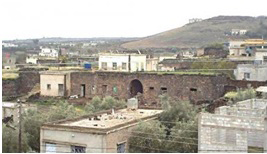Sweida, (ST) – The town of Al -Majdal, located to the north-west of the city of Sweida, is characterized by its charming mountainous nature, the fertility of its soil, the beauty and magnificence of its monuments and the famous vineyards since the time of the Romans.
People lived in Al -Majdal, in the modern era, since the eighteenth century. The name, according to historical documents, is derived from twisting the rope or plaiting the hair. The word Al -Mejdal means the over looking palaces and the word Al -Majdalrefers to a noun of a position in the Arab countries. The researcher at the Antiquities Bureau at the region, Dr. Ali Abu Assaf, pointed out that the name of Al -Majdal backs to the Aramean period.
The town contains several archaeological buildings, where a panel of distinctive mosaic was discovered inside a room built of basalt stone. The primary dimensions of the paintingrange between 303 and 370 centimeters, with a decorated framework of both sides. It contains plants, animals and scenes of children in boats hunting small fish, birds and highlights within four forms of naked women.
That excavation work in the place, where the painting was discovered, shows that it forms a platform of a house and it was probably a part of an archaeological bathroom dates back to the Roman era was disclosed in 2010.
The researcher says that the town also includes an isolated tower cemetery backs to the Byzantine era and consists of two floors and contains two large coffins on the face of one there are engraved decorations encircled with two Crosses and in their façade there are two Greek writings, one says . . “Cross and don’t Envy” and the other says «Here lies near their father the sons of Antiochus’s who is crowned with glory, “Abu Assaf explained.
In 1936, the researcher, J. Masckel, described the cemetery in Al -Majdal as a square tower and the first flour turned to a housing and the ground floor is a cubic where the facade of its entrance is in the form of an ornamented arch. Two stone coffins carrying two Byzantines crosses are found in the wall of the cemetery.
The French researcher, Annie Sartre Forya, presented descriptions, photographs and diagrams to the two archaeological cemeteries of Al -Majdal, stating that one of them destroyed nearly seven decades ago and the funerary text included the name of the builder ” Ma Simos”. The other tower cemetery lies to the northwest of Sweida city about 12 km and contains funerary texts engraved well in Greek.
The researcher, Qutaibaal -Shihabi, described Al -Majdal within his dictionary for archaeological sites in Syria as an archaeological site and a village in the city of Sweidaand was established at the beginning of the eighteenth century. The town includes archaeological sites date to the ages of Nabatiyeh, Romanian, Ghassaniya, Byzantine and Arab-Islamic and includes various buildings mostly intact, and a pagan temple turned into a church in the Byzantine era then into a mosque in the Arab-Islamic times.
Sharif. Al -Khatib

